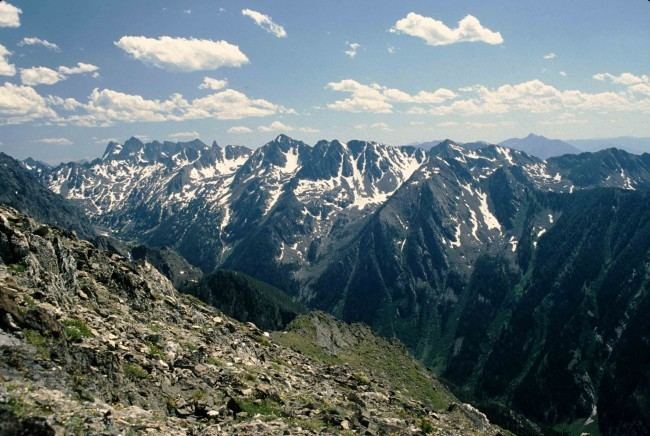Elevation 13,153 ft (4,009 m) | ||
 | ||
Borders on Beartooth MountainsWind River Range Passes Togwotee Pass, Sylvan Pass Mountains Francs Peak, Trout Peak, Emigrant Peak, Pilot Peak, Eagle Peak | ||
The Absaroka Range (/əbˈsɔərkə/ or /əbˈsɔərki/ is a sub-range of the Rocky Mountains in the United States. The range stretches about 150 mi (240 km) across the Montana-Wyoming border, and 75 miles at its widest, forming the eastern boundary of Yellowstone National Park along Paradise Valley (Montana), and the western side of the Bighorn Basin. The range borders the Beartooth Mountains to the north and the Wind River Range to the south. The northern edge of the range rests along I-90 and Livingston, Montana. The highest peak in the range is Francs Peak, located in Wyoming at 13,153 ft (4,009 m). There are 46 other peaks over 12,000 ft (3,700 m).
Contents
- Map of Absaroka Range Wyoming 82433 USA
- GeographyEdit
- HistoryEdit
- GeologyEdit
- Absaroka Volcanic ProvinceEdit
- References
Map of Absaroka Range, Wyoming 82433, USA
GeographyEdit
The range is drained by the Yellowstone River and various tributaries, including the Bighorn River.
Most of the range lies within protected lands including Yellowstone Park, the Absaroka-Beartooth Wilderness, North Absaroka Wilderness, Teton Wilderness, and Washakie Wilderness, spanning the Bridger-Teton National Forest, Custer National Forest, Gallatin National Forest, and Shoshone National Forest.
U.S. Highway 212 from Billings, Montana to Yellowstone climbs over Beartooth Pass 10,947 ft (3,337 m) in the neighboring Beartooth Mountains before winding through the Absarokas to the northeast gate of Yellowstone National Park. It is only open during the summer. U.S Route 14/16/20 follows the Shoshone River from Cody through the range to the eastern gate of the park.
HistoryEdit
The range is named after the Absaroka Indians. The name is derived from the Hidatsa name for the Crow people; it means "children of the large-beaked bird." (In contrast, the Crow name, Awaxaawe Báaxxioo, means "Pointed Mountains [Like Sand Castles].")
John Colter, who may have been the first white person to visit the area, probably traveled along the foot of the Absarokas in 1807 during his reconnaissance of the Yellowstone region. Early explorers also included Gustavus Cheyney Doane and Nathaniel P. Langford, who climbed the summit of Colter Peak in 1870.
USS Absaroka was named after this mountain range.
GeologyEdit
Geologically, the section of the range in Wyoming consists of volcanic breccia, whereas there is a transition to granite and gneiss bedrock further north of the state line.
Absaroka Volcanic ProvinceEdit
Igneous rocks of the Absaroka Volcanic Province cover an area of approximately 23,000 km2 (8,900 sq mi; 2,300,000 ha) in southwestern Montana and northwestern Wyoming, including roughly one third of Yellowstone National Park. These extrusive rocks were erupted during the Eocene Epoch of the Paleogene Period. Radiometric dating has shown that eruptive activity lasted from about 53 to 43.7 million years ago. The eroded remnants of many large stratovolcanoes are found in the area. The dissection of these long extinct volcanoes by erosion allows geologists to see volcanic structures that are impossible to see in active volcanoes. Many terms now widely used in volcanology originated in nineteenth century field studies of these ancient volcanoes.
